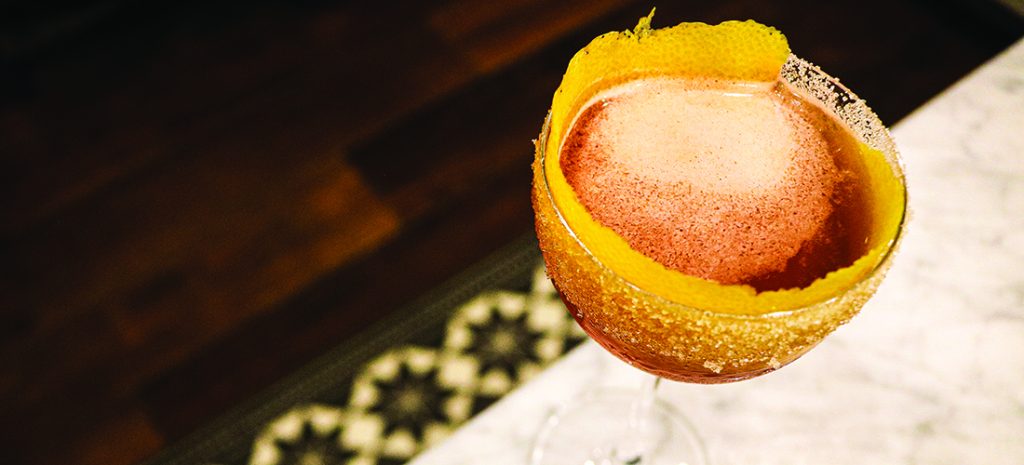In the Spirit

Cognac, Pisco and Applejack
Here’s the story ’bout a spirit named Brandy
By Tony Cross
The other day I was watching Anders Erickson on YouTube, and he was demonstrating how to make the brandy crusta — a classic cocktail that I haven’t whipped up in almost a decade. It got me thinking about the different types of brandy that have been sitting, untouched, in my cabinet. Let’s discuss.
First, what is brandy? Simply put, it’s a spirit distilled from fruit. Cognac, for example, is produced in the Cognac region of France. There are six sub-regions, or appellations, where the grapes are grown. The grapes are fermented after being picked and then double-distilled in copper pots. The “eau de vie” is then aged in oak barrels. Cognac is classified in three different categories: VS (Very Special/Superior), aged for at least two years in oak casks; VSOP (Very Special/Superior Old Pale), aged for at least four years in oak casks; and XO (Extra Old), aged for at least six years in oak casks.
Pisco, another type of brandy, is native to parts of South America, Peru in particular, and is made by the distillation of grape juices and musts (the pulp and skins of crushed grapes). There was a time, long ago, when pisco was the only spirit you could get in the western United States. In Meehan’s Bartender Manual, bartender and author Jim Meehan explains: “Pisco Punch became legendary thanks to Scottish barman Duncan Nicol, who purchased San Francisco’s historic Bank Exchange Saloon — with its house punch recipe — in 1893 and kept it a secret, despite fanfare and public prying, until his dying day in 1926.” Some speculate that Nicol’s secret ingredient wasn’t just the gum arabic, it was cocaine. Meehan says, that might “explain why he permitted only two portions per patron.”
Another type of brandy, this one native to the United States, is apple brandy. An argument can be made that apple brandy has just as much claim to be America’s spirit as bourbon whiskey. Laird & Company, originally based in New Jersey, has been making brandy since the 1700s. Laird’s bonded apple brandy adheres to the same set of standards required for bonded whiskey, yielding a rich, deeply aged, spicy spirit. In addition to apple brandy, there is applejack. This spirit is traditionally produced by freezing distillation, known as “jacking.” Modern applejack is usually a combination of apple brandy and a neutral grain spirit (a 30 percent to 70 percent ratio). France has its own version of apple brandy, called Calvados. Produced in the Calvados region of France, it’s defined by production and aging regulations similar to those for cognac and Armagnac. It tends to have a crisp apple flavor with loads of barnyard funk.
In his YouTube video, Erikson says he never thought much about the brandy crusta because he felt it was more about the presentation than the ingredients in the cocktail itself. That resonated with me. I remembered making the cocktail and thinking that the whole thing was kind of silly. It’s one of the only cocktails that you garnish before you prepare the drink. The copious amounts of sugar crusted on the rim (hence the name) was kind of a turn-off for me. Erikson confessed that if it wasn’t for this cocktail, he would have never tasted the drink that turned him on to bartending — the Sidecar. (Another classic cocktail with links to the brandy crusta.) The lesson I learned is to respect all of the classics — even if it’s not your thing. So, without further ado, here’s Anders Erickson’s recipe:
Brandy Crusta
Take a large lemon and (with a Y-peeler or other peeler) peel around the entire fruit. Cut the lemon in half. Rim a coupe glass with the open half of sliced lemon; dip the rimmed coupe in sugar (don’t skimp). Carefully curl the long lemon peel all along the inside of the glass.
2 ounces Pierre Ferrand 1840 cognac
1/4 ounce Pierre Ferrand dry curaçao
1/4 ounce Luxardo Maraschino Liqueur
1/4 ounce semi-rich simple syrup (1 1/2:1 sugar/water)
1/2 ounce fresh lemon juice
2-4 dashes Angostura bitters
Combine all ingredients in a shaker, add ice, and shake hard for 15 seconds. Double strain into coupe glass. PS
Tony Cross owns and operates Reverie Cocktails, a cocktail delivery service that delivers kegged cocktails for businesses to pour on tap — but once a bartender, always a bartender.
